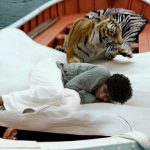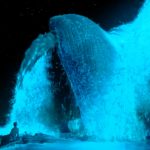Life of Pi – 2012
This was a visually stunning movie with a premise that really makes you think. It contained a twist in the end which throws a new light on the entire film you’ve just watched. The tale is presented as a fantasy, though the true story is eventually revealed. It is clearly a tragic narrative, but it is the protagonist’s way of dealing with that tragedy in the telling of his story that makes the film so interesting.
Pi Patel, is our main character who we are first introduced to as an adult, played by Infan Khan. He is being interviewed by author Yann Martel, the author of the book upon which the movie is based, played by Rafe Spall. He is in search of his lost inspiration. As Pi tells his story in flashback, we learn how he was raised in a zoo in India, along with his parents, Santosh and Gita, played by Adil Hussain and Tabu, and his brother Ravi, played by Ayan Khan. Though he doesn’t have permission, he is daring enough to feed the dangerous Bengal tiger who, due to a clerical error when he was acquired for the zoo, is named Richard Parker. Pi believes that he can see Richard Parker’s soul through his eyes. But when he is caught trying to feed the animal from his own hand, he is made to watch the savagery of the beast as it is fed a live goat. Pi thus learns of the soulless nature of the beast.
When he is sixteen years old, his family is forced to sell the animals of the zoo and move to Canada. They board a Japanese shipping vessel with the animals to cross the Pacific. In the Pacific, a great storm arises to assail the ship. In a fantastical sequence, we see the freightliner sink into the ocean depths, taking all hands and passengers, including Pi’s family, to their watery graves. He becomes stranded on a lifeboat along with an injured zebra, a gentle orangutan, a vicious hyena, and Richard Parker.
In quick succession, the hyena kills the injured zebra and the orangutan, the tiger kills the hyena, and Pi and Richard Parker must learn to survive together. Pi builds a raft so that he doesn’t have to share the boat with the hungry tiger. Eventually the two must work together to stay alive. Pi cannot tame the wild animal, but he feeds him the fish he catches and the rainwater he collects. Then he shouts at the tiger and pokes at him with a boat hook until he is effectively cowed. After the two come to a mutual understanding, they learn to share the single boat.
Pi and Richard Parker experience the ravages of the sun and the sea, starvation, dehydration, and shared madness. Caring for the tiger helps keep Pi sane, though they also share an experience of ephemeral beauty and surreal danger as a giant whale breaches the surface of the sea, destroying Pi’s raft and most of his supplies. But then came the part of them movie that made very little sense, especially in light of the movie’s surprise twist. They reached a mysterious carnivorous island inhabited by thousands of meerkats. There, Pi and Richard Parker regain their strength, but go back out to the ocean before the island can consume them.
They finally reach the shores of Mexico. Pi is heartbroken when Richard Parker leaves him without a glance or acknowledgement of friendship. As the only survivor of the sunken shipping vessel, he is interviewed by the Japanese, to whom he tells his fantastic tale. They don’t believe him, so he tells them the real story of his experience. In it, the zebra was an injured sailor. The orangutan was his mother. The hyena was the mean spirited galley cook, played in the first part of the movie by Gerrard Depardieu. And he himself was the tiger. The cook killed and ate the wounded sailor, then murdered Pi’s mother and tossed her body into the sea. Then Pi murdered the cook. But none of that explained the significance of the flesh eating island, so I’m not sure what I missed.
The whole film cost $120 million to make, though it ultimately grossed $609 million at the box office. The CGI work that made up most of the film’s visual effects were spectacular. Nowhere was this more amazing than the tiger. According to visual effects supervisor, Bill Westenhofer, the tiger was about eighty-five percent CGI and fifteen percent live. But it all looked so real! It was beyond incredible. It is worth watching the movie just to see what the CGI artists were able to accomplish.
Though, there was some controversy concerning the visual effects studio, Rhythm & Hue, which provided Life of Pi with its amazing visuals. The effects for the film were so expensive that Ang Lee neglected to recognize the CGI artists for their participation in making his film when giving his Best Director acceptance speech. In addition to that, when Westenhofer was accepting his Oscar for Best Visual Effects, he tried to thank Rhythm & Hue, which had bankrupted itself creating the effects for Life of Pi. But during that portion of his speech, his microphone was turned off. Apparently, all he was trying to do was to criticize Hollywood for treating visual effects people as simple technicians instead of the artists they are.








